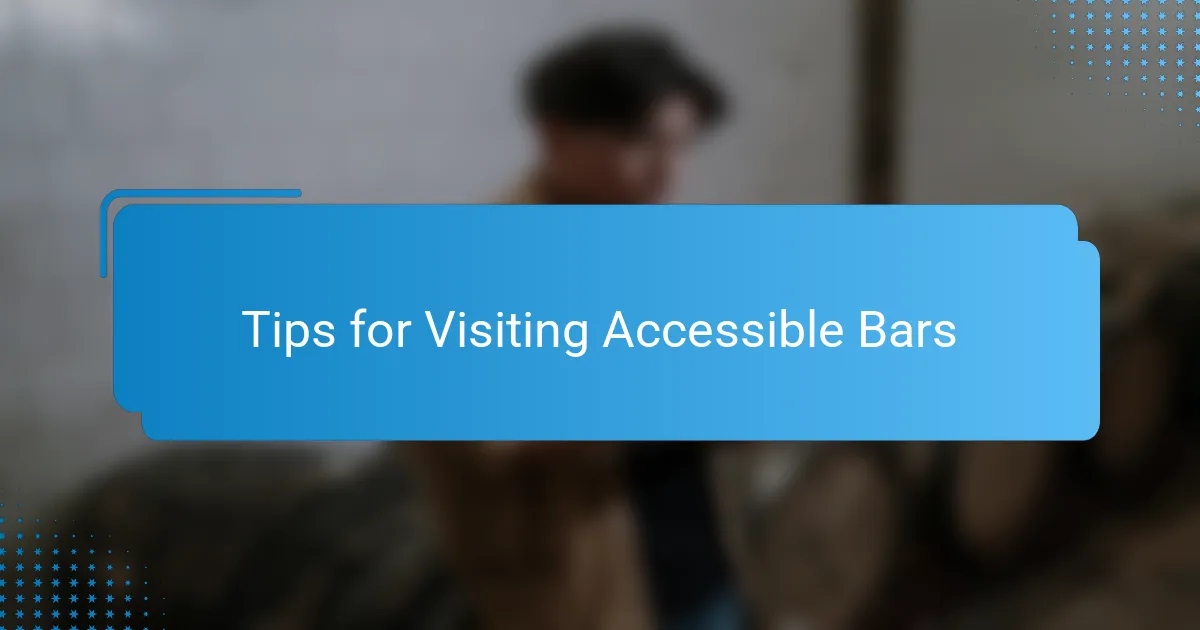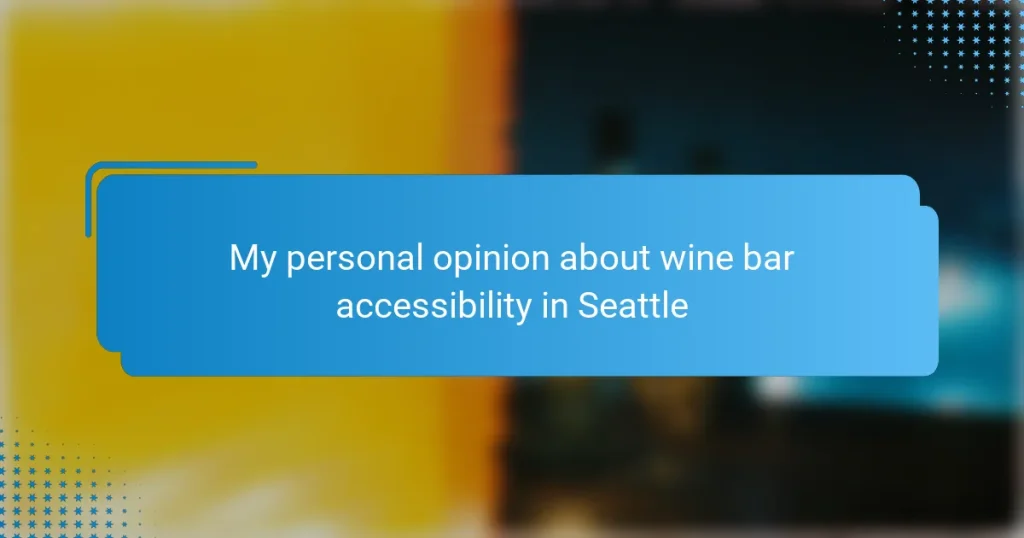Key takeaways
- Accessibility in wine bars goes beyond physical adjustments; it involves thoughtful design and staff empathy to create a welcoming atmosphere for all guests.
- Key features to consider include step-free entrances, varied seating arrangements, and easy-to-read menus, which significantly enhance the overall experience.
- Clear communication about accessibility options and proactive staff support can transform a wine outing from merely acceptable to genuinely enjoyable.
- Improvements such as better signage for accessible features and diverse seating options can help wine bars become more inclusive and inviting environments.

Understanding Wine Bar Accessibility
When I think about accessibility in wine bars, it’s more than just ramps and wide doors—it’s about feeling genuinely welcome and comfortable from the moment you walk in. Have you ever been to a place where you couldn’t find seating that worked for you or had to navigate cramped spaces? That frustration sticks with me and shapes how I view accessibility.
Accessibility also means thoughtful design that allows everyone, regardless of physical ability, to enjoy the experience fully. I recall a visit to a Seattle wine bar where the lighting was just right, menus were easy to read, and staff were eager to help without making things awkward—those little touches made a big difference to me. It made me wonder: how many wine bars consider these details as part of true accessibility?
Ultimately, understanding wine bar accessibility calls for empathy and attention to real-world challenges. It’s not just compliance with regulations but creating an environment where all guests feel included and valued. Don’t you think that’s the kind of place we all want to return to?

Overview of Seattle Wine Bars
Seattle’s wine bars are as diverse as the city itself, ranging from cozy neighborhood spots to sleek, modern lounges. I’ve wandered into some tucked-away gems where the vibe instantly felt inviting, but I’ve also faced tight layouts that made me hesitant to stay long. Doesn’t it make you wonder how these different atmospheres influence who feels welcome?
Many of the wine bars here showcase impressive local selections, yet their physical spaces vary dramatically. I remember one visit where I struggled to find a comfortable spot because the seating was all high stools around a narrow bar—great for some, but a real challenge for others. How often do we pause to think about how seating arrangements impact accessibility?
Despite these differences, there’s a growing awareness in Seattle about creating inclusive wine experiences. Some places even highlight accessibility features on their websites, which I find encouraging—as if they understand that a great wine night should be for everyone, no exceptions. Have you noticed that shift in other wine bars you’ve visited?

Accessibility Features to Look For
One feature I always look for is step-free entrances. I once arrived at a wine bar only to find a narrow set of stairs at the door, which instantly made me feel unwelcome. Have you ever felt that moment of hesitation, unsure if you should turn around or ask for help?
Seating arrangements matter a lot, too. I appreciate when there’s a mix of table heights and chair styles because it shows the place really thought about different needs. Isn’t it nice when you find a spot where you can relax without feeling out of place or uncomfortable?
Menus that are easy to read and available in multiple formats stand out to me. I remember a time when the menu’s tiny font made ordering a frustrating challenge, whereas elsewhere, clear print and digital options made a huge difference. Doesn’t it make you wonder why accessibility in something as simple as a menu isn’t more common?

Evaluating Seattle Wine Bar Options
When I evaluate Seattle wine bar options, I find myself weighing not just the wine list but how accessible the space feels overall. I recall one evening at a downtown spot where the layout was so cramped that maneuvering my wheelchair felt like a challenge course—it’s frustrating when the ambiance is inviting, but the physical space isn’t. Have you ever had your excitement about a night out dampened because the venue’s design wasn’t inclusive?
Another thing that stands out to me is how some wine bars are proactive about sharing accessibility details upfront. It’s refreshing when I can check a website and see notes about parking, entrance ramps, and seating options—it saves me the guesswork and stress of hoping for the best. It makes me think, why isn’t this kind of transparency more widespread?
Then there’s the subtle but important factor of staff awareness and attitude. One time, after sharing my needs, the bartender actually suggested a quieter corner with better lighting and a lower table—that simple kindness really made the experience memorable. Doesn’t it show how much a bit of empathy can transform a visit from merely acceptable to genuinely enjoyable?

Personal Experience with Accessibility
I’ve experienced firsthand how small details in accessibility can make or break a night out at a wine bar. Once, I struggled with a door that was heavy and difficult to open alone—it was a subtle barrier, but it left me feeling a bit excluded. Have you ever noticed how something as simple as a door can influence your whole experience before you even step inside?
There was also a time when seating options really caught my attention. I arrived at a place where chairs with armrests and varied heights were thoughtfully provided, which made it easy for me to settle in comfortably. That kindness in design didn’t go unnoticed; it showed me that the bar cared about more than just serving wine. Doesn’t it make you appreciate when a venue goes the extra mile to accommodate different needs?
What stays with me most, though, is how staff attitude can change everything. At one Seattle wine bar, a server took the time to understand my needs without making a big deal out of it, suggesting the best spot to enjoy my evening. Those moments remind me that accessibility isn’t solely about physical features—it’s about genuine human connection. Have you ever felt that kind of warmth that turns a simple outing into something truly special?

Tips for Visiting Accessible Bars
When visiting accessible wine bars, I always recommend calling ahead to ask about their specific accommodations. It’s surprising how even small details like the location of the accessible restroom or the type of seating can make a big difference in comfort. Have you ever walked into a place only to realize key info was missing or unclear? That little step can save you from unnecessary stress.
Another tip I’ve found helpful is to observe how the staff interacts with accessibility needs. During one visit, a bartender’s genuine willingness to assist—not just comply—made me feel valued. Don’t you think that attitude is just as important as ramps or wide aisles? A welcoming smile and thoughtful service truly enhance the experience.
Lastly, I always look for wine bars that offer flexible seating options and clear pathways. It can be frustrating when spaces feel cramped or when you have to awkwardly squeeze past others. When you find a spot where movement is easy and seating feels inclusive, doesn’t it change how relaxed and enjoyable the whole evening becomes? Those are the places I tend to return to.

Recommendations for Improvement
One thing I’d really love to see more of in Seattle’s wine bars is clearer signage indicating accessible entrances and restrooms. I remember once circling around a stylish spot, frustrated because I couldn’t easily find access points—it felt like the place didn’t quite consider everyone’s arrival experience. Wouldn’t a simple, well-placed sign make all the difference in making guests feel truly welcome from the start?
I also think wine bars could do better by adopting varied seating arrangements that go beyond the usual high stools or tight booths. I’ve found that having comfortable chairs with armrests or lower tables isn’t just a nicety but a genuine need for many. When establishments embrace this, it signals they care about inclusivity in a tangible way—doesn’t that kind of thoughtful design invite you to stay longer and savor the atmosphere?
Lastly, training staff to proactively offer support without making it an awkward moment would elevate the whole experience. Reflecting on my visits, that one bartender who intuitively guided me to a cozy corner with better lighting made all the difference—it wasn’t just accessibility, it was kindness. Could this level of empathy be the secret ingredient that turns accessibility into a joyful, rather than merely functional, aspect of wine bars?




